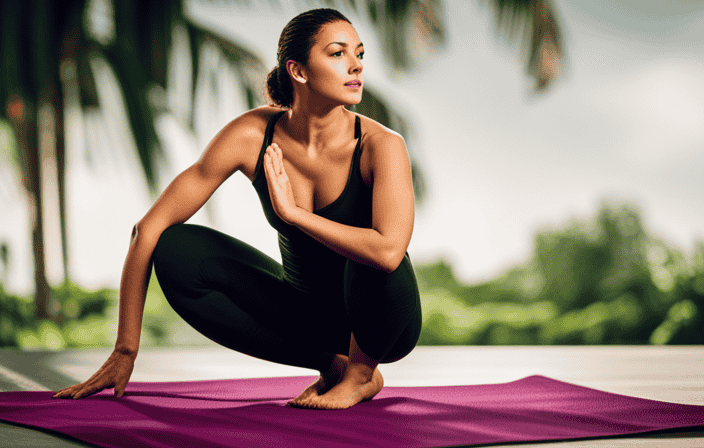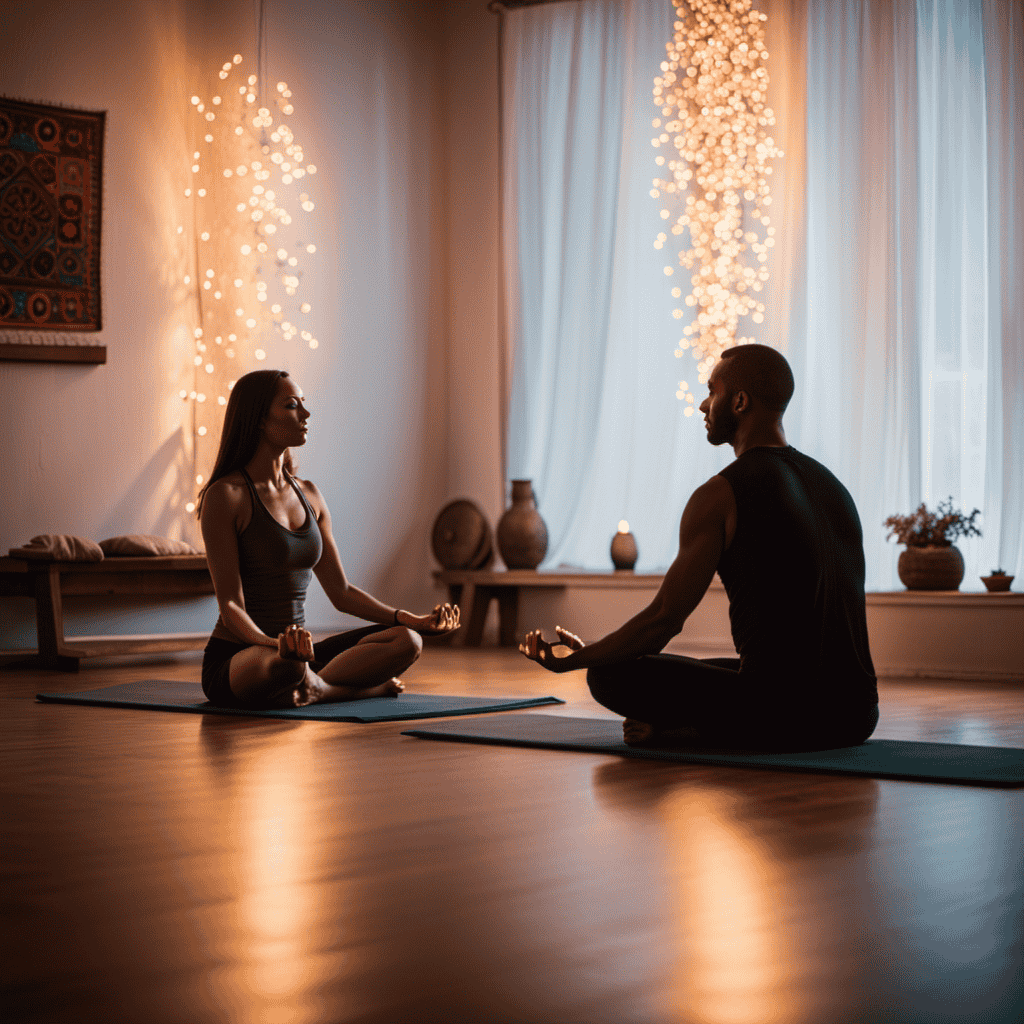Are you aware that engaging in yoga can help alleviate back pain?
Research shows that yoga increases flexibility, reduces muscle tension, and improves posture, making it an effective holistic approach to managing chronic back pain.
In addition to alleviating discomfort, yoga offers benefits such as improved mindfulness and better sleep quality.
By incorporating specific poses and breathing techniques, yoga can help increase oxygen flow and promote relaxation, contributing to pain relief.
Before starting a yoga practice for back pain relief, it is important to consult a healthcare professional to ensure safety and effectiveness.
Key Takeaways
- Yoga is a beneficial practice for managing chronic back pain, as it increases flexibility, reduces muscle tension, and improves posture.
- Specific yoga poses, such as the cat/cow pose and cobra pose, can provide relief from discomfort associated with back pain by improving flexibility and strengthening core muscles.
- Yoga breathing techniques, like diaphragmatic breathing, promote relaxation and help manage pain by increasing oxygen flow and enhancing mindfulness.
- It is important to consult a healthcare professional before starting yoga for back pain relief to ensure safety, effectiveness, and a personalized approach to individual needs.
What is it?
I know that yoga for back pain relief is a beneficial and accessible form of exercise. It increases flexibility, reduces muscle tension, and improves posture.
However, there are some common misconceptions about yoga for back pain that should be addressed. One misconception is that yoga poses can be harmful for those with back pain. While it is important to take precautions and modify poses as needed, yoga can actually help alleviate discomfort and provide relief.
It is also crucial to consult with a healthcare professional before starting a yoga practice for back pain, as they can provide personalized guidance and ensure safety. With the right modifications and guidance, yoga can be a valuable tool in managing chronic back pain and improving overall well-being.
Benefits and Effects
Research shows that practicing yoga can increase flexibility, reduce muscle tension, improve posture, and provide relief from discomfort associated with chronic back issues. The effects of yoga on back pain are significant, as it not only targets the physical aspects but also addresses the mind-body connection.
Yoga incorporates mindful movement and deep breathing, which promotes relaxation and calmness, helping to manage pain. By focusing on the breath and being present in the practice, individuals can enhance their awareness of the body and better manage their pain.
The holistic approach of yoga for back pain relief considers the mental and emotional aspects of pain as well. It provides a well-rounded solution for managing chronic conditions by combining poses, breathing techniques, and mindfulness practices.
With regular yoga practice, individuals can experience improved flexibility, reduced muscle tension, better posture, and overall relief from discomfort associated with back pain.
Specific Poses
One specific pose that can help alleviate discomfort in the back is the cat/cow pose. This pose involves alternately arching and relaxing the back to improve flexibility. When practicing this pose, you may experience a sense of relief and release in your back muscles. It can provide a gentle stretch and help to reduce tension in the spine.
Here are five emotional benefits of incorporating the cat/cow pose and the triangle pose into your yoga practice:
- Increased sense of freedom and mobility in the spine
- Relief from the tightness and stiffness in the back
- A feeling of grounding and stability in the body
- Improved energy flow and circulation throughout the back
- A sense of empowerment and control over your own pain management
By regularly practicing these poses, you can begin to find relief from back pain and improve your overall well-being. Remember to listen to your body and modify the poses as needed to suit your individual needs.
Breathing Techniques
When practicing breathing techniques during yoga, it is important to focus on deep diaphragmatic breaths to increase oxygen flow and promote relaxation in the body. Diaphragmatic breathing, also known as belly breathing, involves breathing deeply into the abdomen rather than shallowly into the chest. This technique helps to activate the relaxation response in the body, reducing tension and promoting a sense of calmness.
In yoga, the mind-body connection is emphasized, and this is particularly true when it comes to breathing. By focusing on the breath and practicing diaphragmatic breathing, we can enhance mindfulness and improve our ability to manage pain. This technique not only helps to relax tight muscles, but it also increases our awareness of the body and its sensations.
By incorporating diaphragmatic breathing into our yoga practice, we can experience the benefits of improved pain management, increased relaxation, and a deeper sense of overall well-being.
Consulting a Professional
Before starting a yoga practice for back pain, it is important to consult with a healthcare professional to ensure safety and effectiveness.
Seeking medical advice is crucial because a doctor can provide guidance tailored to your specific needs and condition. They can help you find the right combination of poses, breathing techniques, and mindful practice to manage your chronic back pain effectively.
Consulting a professional ensures that you are practicing yoga in a way that is safe and beneficial for your back. They can also provide personalized recommendations based on your individual needs, helping you address any concerns or limitations you may have.
With the guidance of a healthcare professional, you can confidently embark on your yoga journey and manage your back pain with expert support.
Accessibility and Adaptability
I can adapt my yoga practice to suit my individual needs, making it an ideal option for seeking relief from back pain. Yoga is a highly adaptable form of exercise that can be modified to accommodate different body types and conditions. When it comes to back pain relief, there are various yoga modifications that can be implemented.
For example, props and modifications can be used to support the body and make poses more accessible for those with back pain. This can include using blocks, straps, or blankets. Modifying poses by using a chair or wall for stability can also be beneficial.
In addition, incorporating gentle movements and stretches can help alleviate back pain without causing further strain. Slow and gentle movements can provide relief and improve flexibility. Targeting the back, hips, and hamstrings with gentle stretches can be particularly effective.
By adapting my yoga practice to suit my individual needs, I can effectively address my back pain and experience the benefits of yoga for overall well-being.
Impact on Sleep and Posture
By improving my sleep quality and posture, yoga helps reduce discomfort and promotes overall well-being.
Regular yoga practice has been shown to have a positive impact on sleep quality, enhancing relaxation and reducing stress levels. By promoting better sleep patterns and deeper rest, yoga can alleviate discomfort and pain experienced during sleep.
Additionally, yoga helps correct posture by strengthening core muscles for better alignment. This reduces strain on the back and spine, correcting imbalances and promoting proper alignment. As a result, overall body posture is enhanced, leading to reduced back pain.
Yoga takes a holistic approach to back pain management, addressing not only the physical aspects but also the mental and emotional aspects of pain. By combining poses, breathing techniques, and mindfulness practices, yoga provides a well-rounded solution for managing chronic conditions and enables individuals to live a more comfortable life with reduced back pain.
Frequently Asked Questions
What are some common causes of back pain that yoga can help relieve?
Yoga can help relieve back pain caused by various factors, such as muscle tension, poor posture, and injuries. By improving flexibility and posture, yoga helps prevent injuries and promotes proper alignment, reducing back pain.
Are there any specific precautions or modifications to keep in mind when practicing yoga for back pain?
When practicing yoga for back pain, it’s important to take precautions and make modifications. Listen to your body, avoid poses that exacerbate pain, and work with a qualified instructor to ensure a safe and effective practice.
Can yoga be used as a standalone treatment for chronic back pain, or is it recommended to be used in conjunction with other therapies?
Yoga can be used as a primary treatment option for chronic back pain, offering a holistic approach to relief. However, it is also recommended to be used in conjunction with other therapies for comprehensive pain management.
Are there any potential risks or contraindications of practicing yoga for back pain relief?
Potential risks and contraindications of practicing yoga for back pain relief include aggravating existing injuries, overexertion, and improper alignment. It’s important to be aware of common causes of back pain and consult a healthcare professional for guidance on safe and effective yoga practice.
How long does it typically take to see improvements in back pain symptoms with regular yoga practice?
With regular yoga practice, improvements in back pain symptoms can vary. Some individuals may experience relief within a few weeks, while others may take several months. Consistency and personalized yoga techniques are key to maximizing yoga benefits for back pain relief.
Conclusion
In conclusion, yoga is a powerful tool for managing back pain holistically. Its benefits range from increased flexibility and muscle tension reduction to improved mindfulness and sleep quality. By incorporating specific poses like the cat/cow, child’s pose, cobra pose, triangle pose, and downward facing dog, individuals can find relief from discomfort and improve their overall well-being.
Additionally, practicing yoga breathing techniques such as diaphragmatic breathing can further promote pain relief and relaxation. It’s important to consult a healthcare professional for personalized guidance.
Did you know that research shows that practicing yoga for just 12 weeks can reduce back pain by 64%? This statistic highlights the significant impact yoga can have on individuals seeking relief from back pain.










